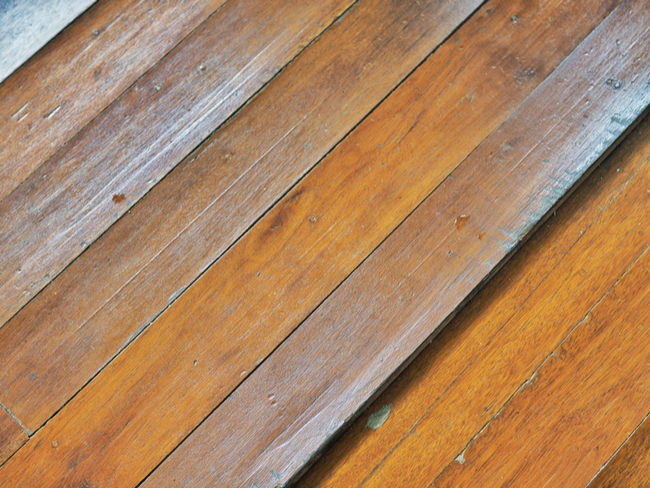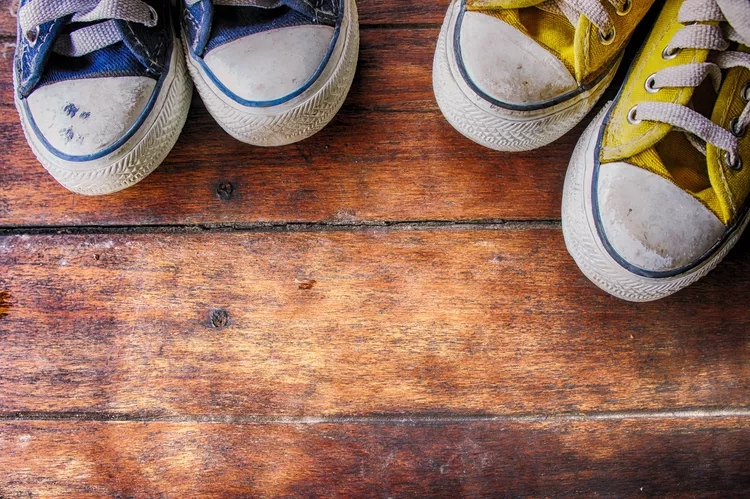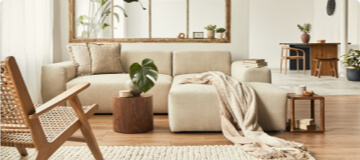There’s nothing quite like a beautiful wooden floor. But without proper installation and maintenance, that gorgeous finish won’t last!
To help you out, we’ve put together a handy list of some common timber floor defects, and how you can avoid them.
1. General wear and tear

Scratched timber floor. Image from The Spruce
You might think of wood and timber as sturdy and resilient, but you still need to take good care of any timber floors in your home. Prevention is, after all, better than cure!
Some of the most common signs of wear and tear are scratches, scuff marks, and dents, usually from furniture. You can avoid this by placing protective pads under your furniture’s feet and by practising care when moving pieces around the home. You can also protect your floors with timber oil — check out our favourite timber oil finishes here.
Your pets can also damage wooden floors. Sharp claws can scratch surfaces, and any toilet accidents can cause permanent stains. Clean up as soon as you spot them to avoid long-lasting damage.
Another common defect in timber floors is fading and discolouration. This happens when spots of wood oxidise under strong sunlight and become darker than in more shaded or covered areas. Try moving furniture around to even out fading, or keep curtains and blinds drawn during the brightest times of the day.
2. Crowning and cupping

Timber flooring cupping (rising). Image from BuildDirect
Crowning and cupping are generally the result of poor-quality installation, with planks rising when they come into contact with moisture. Crowning refers to the centre of the boards rising, while cupping refers to the edges.
Wood absorbs moisture and can warp and move, so it’s important to make sure both the materials and the conditions they’re going to work under are a good fit. Research what wood will work best in your home and be sure to take the local weather into consideration.
You’ll also need to make sure the space is prepared properly before installation. You might want to consider bringing a professional in to do the job, as they’ll be able to advise you on the right materials and make sure everything is put in place correctly.
3. Buckling

A buckling timber floor, usually caused by moisture. Image from Discount Flooring Depot
As with crowning and cupping, buckling is the result of too much moisture being absorbed by your timber floors, though on a much larger scale. When the floor buckles, planks lift right off the floor, and it’s usually the result of flooding or a leak.
To avoid buckling, check regularly for leaks, clean up spills quickly, and keep a close eye on any dehumidifiers or air conditioners you run in your space.
4. Gapping

Timber floor gapping. Image from The Spruce
Gapping is also caused by moisture in the planks, but this time it’s due to lack of it!
Gapping occurs when moisture leaves the wood, causing shrinkage and creating gaps between planks. Floorboards installed during particularly wet or humid conditions will shrink as the water evaporates during drier periods. Some gapping is to be expected as seasons change, but it’s important to minimise the impact.
To do this, research your wood choices thoroughly and install the right planks at the right time of year. And be sure to maintain as stable an environment as possible, so your floors don’t go through extremes.
Timber Flooring Gold Coast
While these are just a few of the common defects we see in timber floors, you shouldn’t let any of them put you off! Do your research and reach out to professionals, and you can have a long-lasting, beautiful wooden floor to be proud of!
For timber flooring on the Gold Coast, visit our showroom.
References:
- Vishal Dhandia, 2019, “7 Common Problems With Wood Flooring”, Castle Bespoke
- “Hardwood Flooring Problems”, Style Timber
- Andrew Mackintosh, “Timber Floor Issues? Here’s What You Need To Know!”, Action Property Inspections





